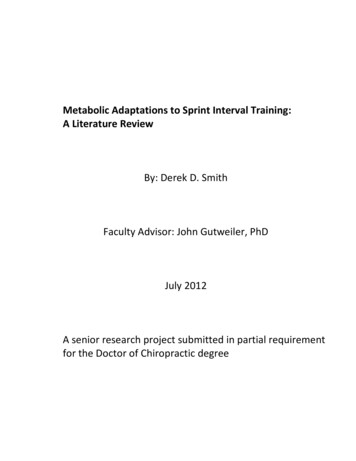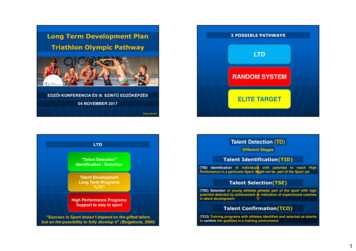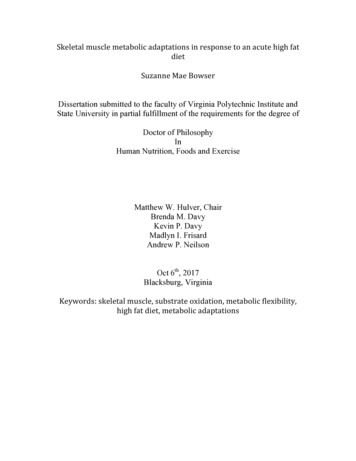
Transcription
Metabolic Adaptations to Sprint Interval Training:A Literature ReviewBy: Derek D. SmithFaculty Advisor: John Gutweiler, PhDJuly 2012A senior research project submitted in partial requirementfor the Doctor of Chiropractic degree
AbstractObjective: To present an overview of the current scientific literature regarding metabolicadaptations and performance improvements resulting from sprint interval training. Toexamine how those adaptations compare to endurance training adaptations for the purposeof demonstrating a time-efficient approach to improve aerobic capacity and reduce metabolicrisk factors.Methods: The PubMed database was searched utilizing the terms sprint interval training,metabolic adaptations, and endurance training singularly or in combination. PubMed, GoogleScholar, textbooks, and websites were cross-referenced to define terminology determined tobe necessary for proper reader understanding.Conclusion: Sprint interval training, characterized by less than 20 minutes of total workoutintensity over a 2-week period, improves muscle oxidative capacity and functionalperformance as effectively as traditional endurance training. Due to the potential forincreased compliance, sprint interval training may demonstrate greater clinical success thanendurance training as a preventative health strategy to reduce metabolic risk factors.Keywords: sprint interval training, metabolic adaptations, endurance training, aerobic,anaerobic, muscle oxidative capacity, mitochondrial enzymes
IntroductionConventional wisdom holds that in order to increase aerobic capacity as evidenced byimproved extended duration performance, an individual has to engage in extended duration,steady state exercise referred to as traditional endurance training. Endurance is defined asthe ability to sustain a prolonged stressful effort or activity or to remain active for a longperiod of time with the ability to resist fatigue.1,2 Traditional endurance training; therefore,includes distance running, cycling, swimming, and other relatively low intensity physicalexercises performed for longer than 30 minutes which depend primarily on the use of oxygento meet the energy demands of training.3,4 The belief that improving aerobic capacityrequires endurance training has been challenged as relatively recent research data has beenpublished revealing that sprint interval training, generally characterized by less than 20minutes of total intensity over a 2-week period, can double endurance performance.5-8Because of the short duration of maximum effort, sprint interval training wouldcharacteristically be described as anaerobic, meaning without oxygen, training. Therefore,anaerobic training is defined as training in the absence of oxidative metabolic pathways inorder to trigger anaerobic metabolism. Anaerobic training is most commonly used by nonendurance athletes to build mass, strength, power, and speed. Because anaerobic trainingis designed to develop muscle energy systems differently than aerobic, endurance training,anaerobic training is characteristically used to improve performance in short duration, highintensity activities comparable to sprint interval training, i.e. sprinting, jumping, weightlifting.As a result, no oxidative metabolic changes or improved endurance performance wouldtypically be expected from a regimen of sprint interval training.1
Numerous physiological adaptations result from endurance training which improve anindividual’s exercise capacity commonly measured by performance andmax. Accordingto traditional thought, increased mitochondrial density improves respiratory control leading toimproved substrate level utilization, i.e. increases in maximal activity of mitochondrialenzymes, with changes in the tricarboxylic acid cycle (TCA cycle) and electron transportchain.6 However, the idea that low-volume, short-duration, high-intensity training has theability to produce adaptations leading to improved endurance performance that relies onaerobic metabolism is the driving force behind recent research.In contrast to extended duration endurance training, sprint interval training minimizeslactate accumulation, i.e. enhances muscle buffering capacity,8-10 and decreases glycogenutilization in addition to improving mitochondrial enzyme activity.7 Therefore, in order tounderstand the role of sprint interval training as a viable aerobic conditioning program, it isimportant to examine the concept of sprint interval training, the various adaptations that itinfluences, the significance of the data during its performance, and the mechanisms by whichit operates. With an established definition of sprint interval training and presentation ofadaptations as well as preliminary comparisons to endurance training adaptations, furtherinterpretation of the research data is necessary to adequately establish the aerobic effects ofsprint interval training.Since sprint interval training involves short, intense, all out bursts, expected anaerobicadaptations would include significantly depleted ATP –CrP system and glycolyticcomponents with negligible changes seen in aerobic adaptations. However, the presenteddata shows significant aerobic adaptations evidenced by increased mitochondrial enzymeactivity including the key mitochondrial marker cytochrome c oxidase and the TCA cycle2
components citrate synthase, malate dehydrogenase, and succinate dehydrogenase.Furthermore, increases in resting muscle glycogen indicate reduced anaerobic activity asmuscle glycogen hydrolysis would serve to provide energy for ATP-PCr systems andglycolysis. Since more muscle glycogen is available post-sprint interval training, someenergy must have been provided via aerobic processes.5-8,11-14 More direct evidence ofaerobic improvement includes increases inmax and muscle oxidative enzyme activitieswhich directly involve oxygen utilization. Finally, improved time trial performance inendurance activities outwardly demonstrates the physiological adaptations previouslydiscussed.MethodsThe PubMed database was searched utilizing the terms sprint interval training,metabolic adaptations, and endurance training singularly or in combination. Searches werelimited to clinical trials, reviews, and comparative studies subsequent to January 1992. Inaddition, searches on Martin Gibala and Kirsten Burgomaster, two prominent researchers onthe topic of sprint interval training, were conducted. References for articles determined to berelevant were evaluated and searched to further develop the working material for the purposeof this review. PubMed, Google Scholar, textbooks, and websites were cross-referenced todefine terminology determined to be necessary for proper reader understanding.DiscussionWith regard to exercise metabolism, assumed knowledge reduces the need tosystematically present each integrated step of the ATP-CrP system, glycolysis, the TCAcycle, and the body’s adaptations to prolonged anaerobic and aerobic conditioning programs.3
However, a discussion of exercise metabolism necessitates a limited presentation of severalkey component steps used to provide statistical data which serves as the basis forcomparison in order to establish sprint interval training as a viable, aerobic capacityincreasing conditioning program. Although substrate utilization is generally different foraerobic states via the TCA cycle and anaerobic states via glycolysis, energy generation andmuscle contraction is ultimately through dephosphorylation of ATP.In anaerobic glycolysis, citrate serves to inhibit the activity of the glycolytic enzymephosphofructokinase. In the mitochondrial, and thereby aerobic, TCA cycle, citrate is anintermediate formed from the condensation of oxaloacetate with acetyl-CoA catalyzed by thekey component enzyme citrate synthase.15 It is important to present citrate synthase as acomponent of an aerobic, mitochondrial process as it is a measurable quantity in sprintinterval training research as a marker of muscle oxidative potential via muscle biopsies.Generally defined, sprint interval training or high-intensity interval training is a form ofexercise that alternates short bursts of high intensity exercise with slower, low intensityrecovery periods within a single workout. However, in order to properly examine its role inimproving aerobic capacity, a more structured definition must be established by presentingsprint interval training protocols as applied in several key studies and the data yielded. Thefollowing research protocols serve as the basis for developing a working definition of sprintinterval training.MacDougall et al’s research conclusions were based on a clinical trial of three trainingsessions per week on alternate days for 7 total weeks.5 Utilizing a Wingate Test, trainingsessions consisted of 30 second maximum-effort intervals against a constant force on amechanically braked pan-loaded Monarch cycle ergometer. The Wingate Test is an4
anaerobic test consistent with sprint interval training characteristics which is typicallyemployed to stress an individual’s anaerobic capacity in order to measure both anaerobicpower and capacity.16 Week one training sessions consisted of four intervals with 4 minuterecovery periods. Two intervals were added per week in weeks two through four whilerecovery periods remained at 4 minutes. The final three weeks consisted of 10 intervals withrecovery periods decreasing by 30 seconds each week.Twelve kinesiology graduate and undergraduate physically active males engaged inweight training, jogging, and intramural sports, but not varsity athletics, were selected toparticipate in sprint interval training as a basis for comparison to previous endurance trainingresearch17,18 No additional exercise training during the study was permitted. Of the subjectsmeeting the criteria, the mean age was 22.7 273.4 6.2, height 175 6, and body mass.Sprint interval training effects onmax and enzymatic adaptations are presented inthe following figures 2-4:5
Fig. 2.Maximum oxygen consumption (V o 2 max)before (Pre) and after (Post) training. Values areexpressed in absolute units (l/min) in A andrelative to body mass (ml kg 1 min 1) in B.Values are means SD; n 12 men.* P 0.05.Fig. 3.Maximal enzyme activity for phosphofructokinase(PFK;A) and hexokinase (Hex;B) before and aftertraining. Values are means SD; n 9 men.* P 0.05.Fig. 4.Maximal enzyme activity for malatedehydrogenase (MDH;A), succinatedehydrogenase (SDH;B), and citratesynthase (CS;C) before and after training.Values are means SD; n 9 men.* P 0.05.6
Interpretation of the data presented shows maximum oxygen consumption (max)increased from pre-training levels of 3.73 0.13 to post-training levels of 4.01 0.08addition toinmax relative to body mass increases from 51.0 1.8 to 54.5asillustrated in Fig. 2. Furthermore, Fig. 4 illustrates significant increases in oxidative markerenzymes with post-training malate dehydrogenase, succinate dehydrogenase, and citratesynthase activities increased 29%, 65%, and 36% respectively. Those increases inoxidative marker enzymes are comparable to earlier research conducted by Linossier et al,19Cadefau et al,20 and Roberts et al21 which served as the impetus for MacDougall et al toexamine the notion that sprint interval training improves muscle oxidative capacity.Linossier et al conducted 7 weeks of repeated 5-second all out sprints in ten studentsexercising on a cycle ergometer after which muscle biopsies were taken from the vastuslateralis. Biopsies demonstrated increases in the slow twitch fibers with concomitantdecreases in fast twitch fibers. Slow twitch fibers are characteristically utilized in endurancetraining as evidenced by the fact that athletes with the highest aerobic and endurancecapacities, including distance runners and cross-country skiers, have the highest percentageof slow twitch fibers.22As a result, Linossier et al concluded that adaptive reactions for slow twitch fibersexhibited greater oxidative capacity following high intensity intermittent training. Cadefau etal investigated the effects of 8 months of sprint interval training on three groups of youngathletes, both male and female. Again biopsies of the vastus lateralis were evaluated.Evaluations demonstrated significant increases in succinate dehydrogenase, therebydemonstrating oxidative metabolic adaptations following an extended period of sprint intervaltraining.7
Roberts et al conducted 16 training sessions over 5 weeks on four male subjects.Sprint-type training consisted of 8 200-m runs at 90% maximum speed, separated by 2minute rest periods. Post-training biopsies of the lateral head of the gastrocnemius wereanalyzed for enzymatic activity. Analysis identified increases in succinate dehydrogenaseand malate dehydrogenase which were not considered relevant at the time because researchwas being conducted on the anaerobic adaptations to sprint interval training rather than theaerobic adaptations as addressed in the current research.It is of particular interest with regard to sprint interval training that MacDougall et alnoted that the “significant increase inmax and the large increases in muscle oxidativeenzyme activity were somewhat unexpected given the nature of the training stimulus and itsbrevity.” Typically, increases inmax and muscle oxidative enzyme activity are associatedwith several hours of aerobic, endurance training per week as demonstrated in research byPhillips et al23 and Wibdom et al.24 The former showed that maximal activity of succinatedehydrogenase, used to estimate muscle oxidative potential, was significantly elevated( 41%; P 0.01) only after 31 days of prolonged endurance training consisting of 2 hours ofsubmaximal cycling. As a result, conclusions were made that adaptations in musclemetabolism linked to increases in muscle mitochondrial capacity required not only endurancetraining, but training carried out over the course of an entire month. The latter researchdemonstrated mitochondrial ATP production rate (MAPR) and mitochondrial enzymeactivities via increases of 40% and 45% in citrate synthase and glutamate dehydrogenaseactivity respectively after 6 weeks of endurance training. Citrate synthase catalyzes theinitiation of the TCA cycle, and glutamate dehydrogenase catalyzes the formation of αketoglutarate, a TCA cycle component. In addition, mitochondrial enzyme activity increases8
were observed in cytochrome-c oxidase and succinate cytochrome-c reductase, two otherenzymes used as markers to demonstrate increased aerobic capacity in sprint intervaltraining.Burgomaster et al recognized the significant contributions of aerobic energymetabolism during repeated sprinting as presented in prior research.6 One study examiningthat contribution tested eight male subjects performing two cycle ergometer sprints. 25 Thefirst sprint lasted 30 seconds, and the second sprint lasted either 10 or 30 seconds with 4minutes of rest between sprints. Two separate tests were conducted which demonstrateddecreases in anaerobic ATP turnover, indicated primarily by a 45% decrease in glycolysis.However, the total decrease in work done on the second sprint was only 18%. Thatdiscrepancy between anaerobic energy release and power output during the second sprintwas determined to be due to the increased contributions of aerobic metabolism.Given the significant contributions of aerobic energy metabolism during repeatedsprints,25,26 and the increase in muscle oxidative potential indicated by changes in citratesynthase as a marker enzyme,5,11,27 Burgomaster et al presented data from a clinical trialcomprised of six training sessions spread over 14 days.6 The eight subjects included in theresearch were recreationally active and 22 1 year of age withpeak equal to 45 3. Recreationally active was defined as individuals participating in some form ofexercise including jogging, cycling, and aerobics two to three times per week, but not in anystructured training program. Each session consisted of repeated 30 second “all-out” effortson an electronically braked cycle ergometer against a resistance equivalent to 0.075with 4 minute complete rest or low cadence ( 50 rpm) recovery periods betweentests. The number of intervals completed per training session increased from 4 to 7 over the9
first five training sessions and four intervals on the sixth and final session. This particularsprint interval protocol was designed to test the hypothesis that six sessions of sprint intervaltraining performed over two weeks would increase citrate synthase activity,peak, and theendurance time to fatigue during cycling.Pre- and post-training biopsies of resting muscle were measured for citrate synthasewhich has been demonstrated to be the most used enzymatic marker of muscle oxidativepotential, existing in constant proportions to other recognized mitochondrial enzymes.5,11,27Post-training maximal activity of citrate synthase and resting muscle metabolicconcentrations of glycogen increased by 38% and 26% respectively as summarized below:Maximal activity of citrate synthase (CS)measured in resting muscle biopsy samplesobtained before and after a 2-wk sprint trainingprotocol. Values are means SE for 8 subjects,ww, Wet wt. *P 0.05.Muscle glycogen concentration measured inresting biopsy samples obtained before and aftera 2-wk sprint training protocol. Values are means SE for 8 subjects. dw; Dry weight. *P 0.0510
The post-training increase of glycogen in resting muscle is an indication that theanaerobic, glycolytic pathway is not being activated as substantially as would typically beexpected. The post-training maximal activity increase in citrate synthase is comparable toother reported increases resulting from sprint interval training, with an emphasis that theother research utilized protocols with significantly more intervals.5,11,12,27Other research which failed to show an increase in citrate synthase was discrediteddue to the fact that the protocols implemented very short sprints lasting less than 10seconds. Ten second sprint intervals is in stark contrast to those studies reporting increasesin citrate synthase which utilize 15-30 second maximal effort sprints. More importantly, indeveloping a case for oxidative, metabolic adaptations to sprint interval training, the posttraining increase in citrate synthase is comparable to increases resulting from endurancetraining13,14 However, the increase in citrate synthase is in contrast to still other researchreporting no changes in muscle oxidative potential from short-term endurance training.28In addition, post-training cycling endurance capacity improvements ranged from 81 to169% compared with pre-training baseline. Also noted as the “primary novel findings” of thestudy were muscle oxidative potential increases with endurance time to fatigue at 80%peak cycling increasing 100%. From that data, it was concluded that short, repeatedbouts of all out cycling (sprint interval training) “favorably altered the resting metabolic profileof human skeletal muscle.”Subsequent to the aforementioned “primary novel findings,” Gibala et al directlycompared sprint interval training and endurance training in a standardized manner in order todemonstrate the similar metabolic and performance adaptations that time- efficient sprintinterval training could induce.29 While it had been speculated that sprint interval training11
could induce such adaptations,30 the research is considered to be the first that actuallydemonstrated that fact by recruiting sixteen physically active men participating in recreationalexercise two to three times per week and randomly assigning eight to a sprint intervalprotocol and eight to an endurance protocol in order to make the direct comparison. Sprintinterval training protocol was similar to that previously described.6 Endurance trainingprotocol consisted of 90-120 minutes of continuous cycling at 65%peak with 1-2 days ofrecovery between training sessions. The endurance training protocol was patterned afterprevious work,14,31 and the entire study was designed to produce an equal number of trainingsessions on the same days with the same number of recovery days between the two groups.For the basis of performance adaptations, performance tests included 50 kJ and 750 kJ, totalenergy expended, cycling time trials with the former taking approximately 2 minutes and thelatter approximately 1 hour to complete. As a result, the energy contributions from oxidativeand non-oxidative metabolism were considerably different. Based on findings from priorresearch,5,6,13,14 it was hypothesized that both types of training would increase muscleoxidative capacity, and therefore, improve the 750 kJ time trial performance because of theenergy contribution from aerobic metabolism required to complete the 1 hour task. Incontrast, only the sprint interval training group was expected to improve on its 50 kJ time trialperformance due to the increased muscle buffering capacity resulting from sprint intervaltraining and the energy contribution from anaerobic, non-oxidative, metabolism required tocomplete a 2 minute task.While completing time trials, subjects only received feedback based on the amount ofwork completed. Work completed was presented as “distance covered” on a computer12
monitor. In other words, 50 kJ and 750 kJ corresponded to 2 km and 30 km respectively,with subjects being provided units of distance rather than work completed during time trials.The distinctive purpose of the study was to compare exercise capacity and molecularand cellular adaptations between the sprint interval group and endurance training group aftertwo weeks of training. With regard to exercise capacity, i.e. the ability to sustain a givenworkload for a longer duration of time, thereby decreasing the time necessary to complete atask, or attain a higher average power output, measured in watts (W) over a predetermineddistance or time,32,33 both training protocols demonstrated comparable improvements in the750 kJ cycling test. Recalling that the 750 kJ cycling test is characteristic of aerobic training,the time required to complete the cycling time trial post-training decreased by 10.1% in thesprint interval training and 7.5% in the endurance training groups. The mean power outputalso improved with an increase from 212 17 to 234 16 W and 199 13 to 212 12 W inthe sprint interval training and endurance training group respectively.Changes in skeletal muscle substrate metabolism to identify molecular and cellularadaptations were determined via muscle biopsy samples obtained pre- and post-training.Biopsy samples from both training groups revealed similar increases in muscle oxidativecapacity. Muscle oxidative capacity was indicated by an increase in the maximal activity ofcytochrome c oxidase, a respiratory electron transport chain enzyme located in themitochondrial membrane, and cytochrome c oxidase subunits II and IV protein content.Additional findings included an increase in muscle buffering capacity and restingmuscle glycogen. Muscle buffering capacity increased post-training by 7.6% for the sprintinterval training group and 4.2% for the endurance training group. The resting muscle13
glycogen content showed post-training increases of 28% and 17% for the sprint intervaltraining and endurance training groups respectively.Following Gibala et al’s research, Burgomaster et al conducted research to not onlyconfirm but expand on their and Gibala et al’s work described above which showed similarincreases in muscle oxidative capacity between sprint interval and endurance training.Because the prior research findings were based on short, two week studies, it could beargued that the equivalent comparisons were the result of sprint interval training stimulatingrapid skeletal muscle remodeling; whereas, the full effects of endurance training with sloweradaptive processes could not be appreciated over the course of only two weeks. 7 Moreover,the single marker of muscle oxidative capacity, citrate synthase, in the former study provideda limited perspective on the potential for metabolic changes. Therefore, new researchprotocols were designed to “compare changes in markers of skeletal muscle carbohydrateand lipid metabolism and metabolic control during matched-work exercise, before and after 6weeks of low-volume sprint interval training or high-volume endurance training.”For the purpose of this study, sprint interval training consisted of three trainingsessions per week for six weeks. Training sessions consisted of four, five, and six repeatedWingate Tests during weeks 1 & 2, weeks 3 & 4, and weeks 5 & 6 respectively. Recoveryperiods for all training sessions consisted of low cadence ( 50 rpm) cycling for 4.5 minutes.Endurance training, by contrast, consisted of continuous cycling at 65% ofpeak for 40 -60 minutes, 5 days a week for 6 weeks. By design, the weekly exercise volume as definedby amount of energy expended, or work done, in applying a force of one newton through adistance of one meter, also known as a joule, was 90% lower for subjects performing thesprint interval training protocol.14
Prior to conducting the trial, it was hypothesized that despite significant trainingvolume and time commitment differences, sprint interval training and traditional endurancetraining would induce comparable adaptations in muscle oxidative capacity and improveperformance. In order to exemplify the significant contrast in training volume and timecommitment, a summary of sprint interval training versus endurance training protocols ispresented:Summary of sprint interval training (SIT) and endurance training (ET) protocolsVariableSIT Group (n 10)ET Group (n 10)ProtocolTraining Intensity30 s x 4-6 repeats, 4.5 min rest( 3 x per week )“All out” maximal effortWorkload( 500 W )Weekly Training 10 minTime commitmentWeekly training volume*40-60 min cycling( 5 x per week )65% ofpeak*( 150 W ) 4.5 h( 1.5 h including rest ) 225 kJ 2250 kJpeak, peak oxygen uptake15
As noted from the presented data, weekly training volume and time commitment for sprintinterval training was 90% ( 225 kJ versus 2250 kJ per week) and 67% ( 1.5 h versus 4.5h) lower than endurance training. Furthermore, with regard to time commitment, it isimportant to recognize that a significant majority of the training time is actually spent inrecovery between short, intense all out bursts of cycling.Similarly, with respect to previous research, adaptations in selected skeletal muscleCHO markers, lipid metabolism, and metabolic control during exercise compared favorably tothose seen in endurance training. In addition, muscle oxidative capacity and citrate synthasemaximal activity increases after 6 weeks of sprint interval training were similar to theincreases in cytochrome c oxidase after 2 weeks training in prior studies. That comparisonlead to the conclusion that most of the increases in mitochondrial content occur early in thetraining process. The premise that “pulmonary oxygen () uptake in the transition from restto constant cycle exercise does not rise instantaneously though certainly very rapidly to alevel corresponding to the amount of work performed”7 was first presented by Krogh &Lindhard34 and further supported by Krustrup35 et al whose research demonstrated that at theinitial phase of high intensity interval training, but not low intensity, oxygen uptake, bloodflow, and vascular conductance all increased.Other data presented to emphasize comparable improvements in exercise capacitybetween sprint interval training and endurance training included heart rate, respiratoryexchange ratio, ventilation, and. Improvement in heart rate is arguably one of the mostrecognizable physical adaptations to the average layman that represents increased aerobiccapacity as summarized in the following work from Burgomaster et al which represents preand post-training cardiorespiratory data:716
Cardiorespiratory data during cycling exercise at 65%peak before and after 6 weeks ofsprint interval training (SIT) or 6 weeks of endurance training (ET)SIT GroupHeart Rate ()RER*Ventilation (())ET GroupPrePostPrePost160 5151 6157 5144 50.977 0.010.965 0.010.967 0.010.941 0.0148 342 347 542 427.7 1.026.6 1.026.1 1.125.3 1.8*RER, respiratory exchange ratio;, oxygen uptakeWith prior research having established sprint interval training effects on oxidativecapacity and performance based primarily on Wingate Tests, Little et al presentedconclusions from a clinical trial designed to determine the metabolic, molecular, andperformance adaptations to a “more practical method of low-volume high intensity training.”8Other research had demonstrated metabolic adaptations with more practical sprint intervaltraining protocols,36,37 but Little et al questioned the time efficiency of those protocols astraining sessions exceeded 60 minutes in duration. It was believed that Wingate Tests, withmaximal effort, variable-load exercise protocols were not practical due to the extremedemands of training and the specialized equipment required. Furthermore, safety concernswere considered since the extreme demands of training via Wingate Tests might not be welltolerated by individuals, i.e. the general public, wanting to receive the established benefits ofsprint interval training.Seven men, 21 0.4withpeak 46 2, completed the clinicaltrial consisting of six training sessions over 2 weeks. Each session consisted of repeated 6017
second efforts of high-intensity cycling at 100% peak power output. High-intensity cyclingefforts corresponded to the peak power achieved (355 10 W) at the end of the ramppeak test. Each interval was separated by 75 seconds of low intensity (30 W) for recovery.Eight high-intensity intervals were completed in sessions one and two, ten intervals insessions three and four, and twelve intervals in session
understand the role of sprint interval training as a viable aerobic conditioning program, it is important to examine the concept of sprint interval training, the various adaptations that it . Sprint-type training consisted of 8 200-m runs at 90% maximum speed, separated by 2-minute rest periods. Post-training biopsies of the lateral head of .










